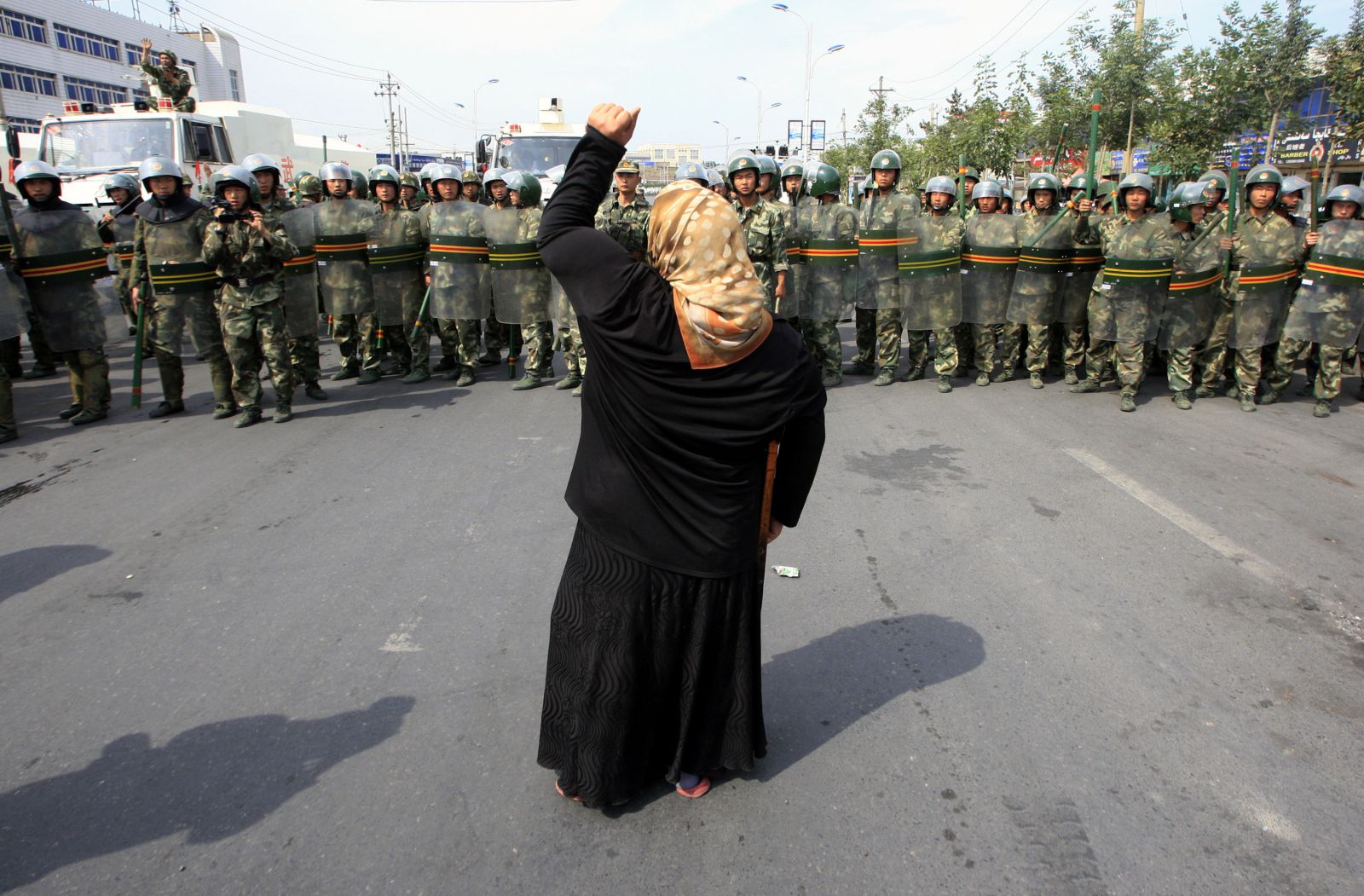
A local woman on a crutch shouts at Chinese paramilitary police in China’s Xinjiang Autonomous Region. (Reuters/David Gray)
Twenty years ago, Beijing hosted a landmark international summit on women’s rights. This weekend, China’s president Xi Jinping reiterated his country’s “commitment to gender equality and women’s development.”
These are bold words, but they ring hollow. Because for 60 years, China has used the language of women’s rights, along with human rights, secularism, and even anti-terrorism, to justify the occupation of a people, the dilution of their population, and the erasure of their national identity.
If you’re thinking Tibet, you’re right—sort of. Because while China has in fact spent decades subjucating the Tibetan people, there is another Tibet, one that far fewer people know about.
Sixty years ago, on Oct. 1, 1955, the Chinese government formed the autonomous region of Xinjiang. (known to locals as Uighurstan, or East Turkestan). While the Xinjiang region has experienced remarkable technological advance in industrialization under Communist rule, such advances have come at great cost to the indigenous Uighur people’s culture, heritage and individual and national rights.
While China has in fact spent decades subjucating the Tibetan people, there is another Tibet, one that far fewer people know about.
The native majority, mostly Muslim and Turkic peoples who have come to be known collectively as the Uighurs, were the overwhelming majority in 1955. Today, they have become a mere plurality in their own land. For all Xi Jinping’s talk of women’s rights, Uighur women are told how to dress (and punished for disobeying); meanwhile, Uighur men are forbidden from growing beards, and Muslims are prevented from fasting in Ramadan. There are of course severe restrictions on other forms of spiritual life in China, which likewise cannot be reduced to the hostility of a secular state to faith.
In Xinjiang, restrictions on women’s rights, as well as religious and cultural rights, are a kind of “politicide,” the organized project of erasing a people’s national identity, focusing on its religion component. It’s not hard to see why China would want to: The Uighur are closely related to the peoples of the Central Asian “-stans,” who were liberated from Communist rule in 1991 (only to fall largely under local dictatorship). Their territory is one of the largest administrative subdivisions in the world; it’s nearly the size of Alaska.
It is home to major resources, and a critical component of China’s push to develop overland trade routes across Eurasia.
The Uighurs are simply in the way. Since their conquest and occupation, the Chinese have pursued the same kind of settlement strategy Israel has, colonizing Uighur land in order to seize resources and establish demographic preponderance. Of course, Han Chinese vastly outnumber Turkic-speaking indigenes, which means the Uighur are not only politically restricted, but feel existentially threatened.
Concurrent with its occasional reliance on a language of human rights and women’s development, China freely indulges in former US president George W. Bush’s deeply irresponsible language of a global war on terror, justifying draconian security crackdowns in the face of a threat—arguably caused by the crackdowns themselves.
World leaders are meeting this week to discuss the threat of terrorist groups, and especially the Islamic State. I would not be surprised if we see a concerted push by Islamic State propagandists and recruits to target disaffected Uighur; in the past, after all, Uighur and Central Asian jihadist groups have been affiliated with the Taliban, and cited by al-Qaeda. China will no doubt use such connections to justify its security policies, while missing the larger point: Populations that are deeply, systematically and continuously marginalized, mistreated and maligned will turn to violence, even spectacular and radical violence, because they see no other option.
The Xinjiang region is home to major resources and overland trade routes across Eurasia. The Uighurs are simply in the way.
Given China’s massive size, wealth, and the reluctance of many international leaders to criticize its human rights records, the Uighur are left even more helpless.
But there is still a chance the Uighur struggle could prevail peacefully. As in all such conflicts, the occupying power shapes the nature of resistance. In this case, China’s occupation of East Turkestan has produced a leader, one opposed with almost as much vehemence as the Dalai Lama: Rebiya Kadeer.
Kadeer reflects Chinese policies aimed at gender equality. A successful businesswoman turned political activist, she has however become an outspoken advocate for her people’s struggles against Chinese rule even as, in her life story, she challenges patriarchal norms within Muslim communities. There are after all very few Muslim nations led by women, formally or otherwise.
A more accommodating China could work with Kadeer, and present her life story as evidence of its commitment to women’s rights, education and advancement. Assuming, of course, president Jinping means what he says.
Follow Haroon on Twitter at @hsmoghul. We welcome your comments at ideas@qz.com.




 Print
Print Email
Email